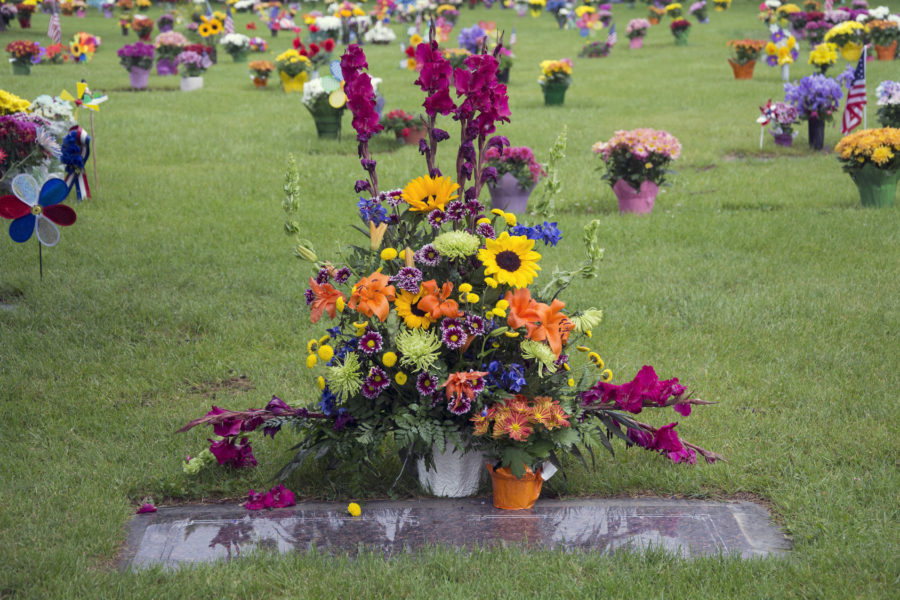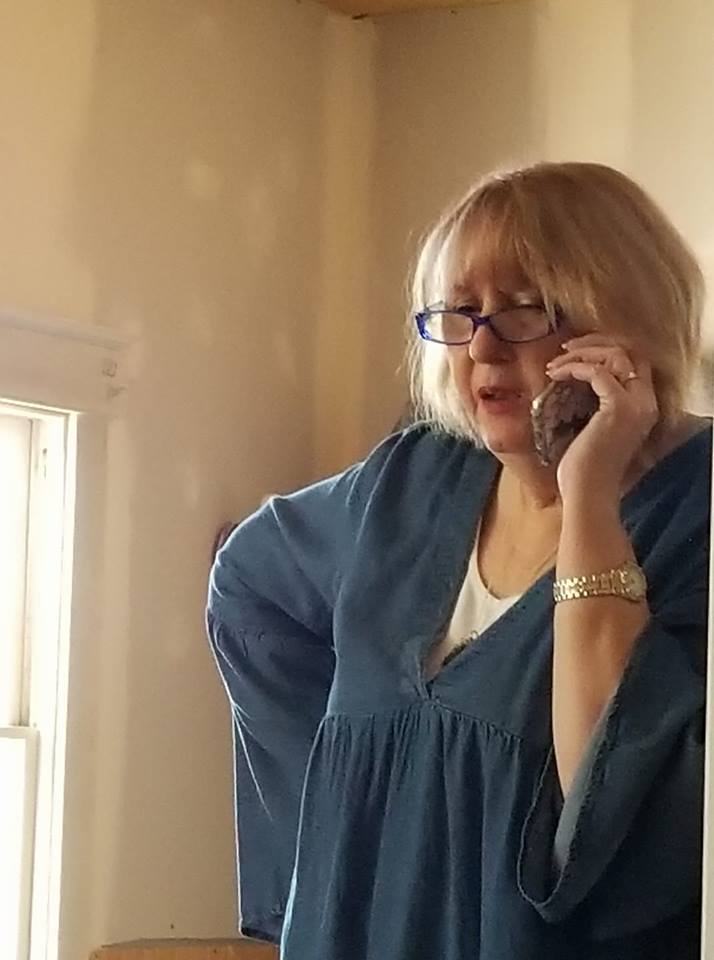Do you know the meaning of the flowers you place on your loved one’s grave site? How about why certain trees are found in a cemetery?
By Rebecca Nidey
Everything I Need To Know I Learned In A Haunted House
This year the groundhog predicted an early spring and I think it confused Mother Nature. Here in Illinois we seem to go from one extreme to another. One day we may have several inches of snow and below freezing temperatures and then in a few more days it will be in the sixties with birds chirping and buds rising. As I went out my front door today I saw the first green of my tulips beginning to rise above the muddy earth and it reminded me that the blooms would not be hidden much longer.
Flowers and other plants and trees have always been an indication of the season, but did you know that they also symbolize the seasons of our lives? As far back as the times of the pharaohs, flowers were found in the tombs of royalty. Several holidays, both old and new, are centered around flowers. An important part of the celebrations of All Souls’ Day/Day of the Dead and Memorial Day is the placing of flowers on the graves of the honored dead. All holidays also have floral symbols associated with them. Each month of the year has a symbolic flower (I was born in October and mine is the marigold).
Being an avid explorer of cemeteries, I have often noticed flowers, trees and plants growing in some of the older graveyards that I have visited. Newer cemeteries do not allow live flora to be planted there except as their own landscaping, but fresh and silk flowers are allowed as signs of remembrance. Many cemeteries are even named after the flora surrounding and included in the area: Oak Grove, Roselawn and Pine Ridge are ones that come to mind.
Many religions use flowers as symbols and Paganism has blended with Christianity in those uses. The Madonna is often depicted holding roses, but they are also a symbol linked to the Mother Goddesses Demeter and Isis, and so became a modern symbol of all mothers. The lily is one of the symbols of Hera, but is also another flower that has been seen in pictures of The Madonna. An iris has pointed blade like leaves that resemble palm fronds, a symbol of Palm Sunday, but is also reminiscent of the reeds of the Nile and so are an ancient sign of royalty in Egypt.
In traveling to local cemeteries, I have visited many older cemeteries where there are living plants surrounding the grave sites, stones and other areas. Since there seemed to be many that were reoccurring, I decided to do some research to see if there was symbolism behind them. If the climate of the area was not conducive to growing these plants they would often be carved into the stones.
Here is a short rundown of some of the flora that I have found in my jaunts:
Fern: Ferns symbolize protection and health, if not in this life… in the afterlife.
Hibiscus: This floral plant can mean love and divination.
Hyacinth: This beautiful and fragrant flower represents love, protection and happiness.
Ivy: Ivy is a symbol of protection, healing, immortality and death.
Thyme: This herb means healing, purification and courage.
Daffodil (Narcissus): This beautiful bulb plant is a sign of spring and represents rebirth or resurrection.
Morning Glory: They symbolize resurrection as they close their petals in the dark and open them in the morning.
Rose: Roses are symbolic of motherhood but can also stand for passion, love and purity depending on their color.
Easter Lily: Another regal flower that is a sign of purity or casting off of earthly bonds to attain heaven.
Marigolds: Marigolds are a symbol of grief. They are bright and sunshiny during the day but fold their petals tightly and droop at night. A larger variety is often used during Day of the Dead ceremonies as they are thought to help guide home the souls of the deceased.
 Pansies: These shy flowers are often found on the graves of women. They were especially used during the Victorian era to symbolize tender attachments, concern, compassion, humility and remembrance. The blossoms were a way to remind the mourners to “keep me in your thoughts.” They are also called heartsease because of their heart shape and the name pansy is derived from a French word meaning thought.
Pansies: These shy flowers are often found on the graves of women. They were especially used during the Victorian era to symbolize tender attachments, concern, compassion, humility and remembrance. The blossoms were a way to remind the mourners to “keep me in your thoughts.” They are also called heartsease because of their heart shape and the name pansy is derived from a French word meaning thought.
Periwinkle: These beautiful flowers symbolize tender recollections.
Passionflower: This vining plant is a symbol of Christ’s passion, crucifixion and resurrection and thus life after death.
Daisy: Daisies are signs of joy, happiness, beauty and innocence.
Iris: The meaning of this regal bloom is hope, faith, valor and peace.
Forget-me-not: The meaning of this tiny flower is obvious; faithful love, undying memory and constancy.
Lily of the Valley: This bell shaped flower means a return to happiness, hope, sweetness and humility.
Azalea: This shrub with red or orange blossoms symbolizes the fragility of life.
Hydrangea: A large flower, the hydrangea represents appreciation and friendship.
Poppy: This flower has gained notoriety in the years since WWI when it became symbolic of Veterans Day. The famous poem by John McCrae states that poppies grow over the dead buried “In Flanders Field.” The poppy symbolizes peace and eternal sleep for the departed.
These are just a few living plants that have become a symbolic part of the local gravesites. Because of the regional climates, I know that there are many other plants I have not mentioned. Yucca plants to crepe myrtle, they all are used in some way to honor and remember those who have passed. In most cemeteries of any age there are also trees planted for beauty and shade but they also have secret meanings.
Cypress Tree: Since pagan times the Cypress has been associated with death and immortality. This tree, when cut down, never grows again from the remnants of its roots… showing the finality of death. Its form is like fingers pointing toward heaven.
Oak Tree: The oak tree is considered to be the King of trees. Druids used it in many of their ceremonies, but it is also a Christian symbol of strength, honor, endurance, faith, virtue, and eternity. The oak was a sacred tree to the Norse, Romans, and Greeks also.
Weeping Willow: The symbolism of this tree is self-evident….eternal grief and tears for the passing of those we love.
 Olive Tree: As the tree most referenced in the Bible, it is also appropriate for cemeteries. It reminds those present of the peace pact made between God and man after the great flood.
Olive Tree: As the tree most referenced in the Bible, it is also appropriate for cemeteries. It reminds those present of the peace pact made between God and man after the great flood.
Pine Tree: The pine tree and other evergreens are symbolic of immortality and incorruptibility.
Personally, I have always thought that the trees in various cemeteries served as reminders of the family trees that were laid out in stone on the grounds. Their shade provides comfort during our times of grief just as our loved ones did in life. The flowers provide fragrance when we visit those who have passed on. That fragrance sometimes creeps up on us just as memories sneak into our minds and hearts.
Although cemeteries seem to be places of sorrow, we should visit them (if not in body, in spirit) with the idea that they are places of remembrance. As we lay flowers on the graves of our parents and grandparents, relive the times you sat in their laps… feeling safe and loved as they told you stories. As you visit the stone of those who have died very young, think of the brief time you held them in your arms but also the long time you will hold them in your heart. Laugh over the jokes a friend told you when you visit while you shed a few tears that they are no longer there in body.
A cemetery is as much about life as it is about death. Visiting with those who have passed does not even require a physical trip to where their bodies now lie. As it has been said: There is a time for every activity under heaven; a time to be born and a time to die, a time to plant and a time to uproot… a time to weep and a time to laugh.
I would like to add something to this, there is a time to make memories and a time to remember. Please remember to make some good memories now that you can take out for a rainy day. Plant some flowers and enjoy their fragrance just as you enjoy beautiful memories. Sit under a tree and remember the branches of your family. When you visit a cemetery, remember the lives of those who reside there, not their deaths.
About the Author:
 Through her work on the investigative team for the Crawford County Illinois Ghost Hunters, Rebecca Nidey has an understanding of the paranormal, spiritual, and metaphysical worlds and how they work together.
Through her work on the investigative team for the Crawford County Illinois Ghost Hunters, Rebecca Nidey has an understanding of the paranormal, spiritual, and metaphysical worlds and how they work together.
Rebecca has trained in the Healing Touch technique (a form of energy healing). She is a certified Psychic Medium trained by Belle Salisbury, and she is a certified Paranormal Researcher.
Rebecca is the associate editor for Bellesprit Magazine and also writes a column titled Everything I Need To Know I Learned In A Haunted House. She has been a co-host of several radio programs for the Haunted Voices Radio Network and HeyZ Radio Network highlighting the Paranormal, metaphysical and literary fields.
To learn more about Rebecca or to schedule a reading you can contact her at https://www.facebook.com/rebecca.nidey.




